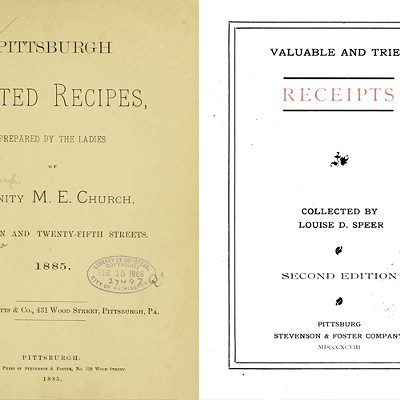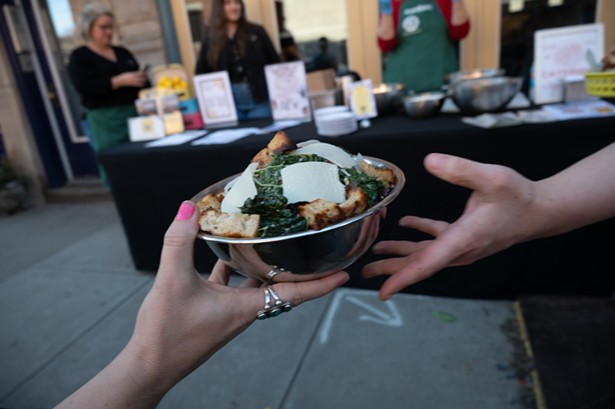Korean food is a bit of the odd man out in the American universe of Asian restaurant cuisines. Chinese, from take-out in greasy cardboard boxes to authentic delicacies in lacquered bowls, is venerable and familiar; Japanese enjoyed such popularity in the '80s that we now expect to find sushi alongside pasta salads in the prepared-foods aisles of grocery stores; and over the past decade or two, the various cuisines of Southeast Asia have filled the storefronts of suburban strip malls as well as urban restaurant rows with their heady, herbal aromas.
But where has that left Korean, which marries a heartiness akin to Chinese with a piquancy evocative of the spiciest Southeast Asian curries? Around these parts, at least, Korean restaurants have tended to hedge their bets, augmenting authentic peninsular dishes with sushi. (And can we note here just how odd it is that Americans need to be lured to a cuisine replete with grilled meat by the promise of raw fish?) As a result, a couple of Korean dishes may have become familiar to Pittsburgh's most adventurous diners, but the overall profile of Korean cuisine remains hazy at best.
In Squirrel Hill, a couple of newlywed entrepreneurs have decided to tackle this situation head-on. Jake Young wanted to start a restaurant with food as good as the traditional Korean fare his wife, So, cooked at home. If invitations to their house for dinner were so sought-after, why not extend this remarkable hospitality to the family business?
With the Youngs at the helm of both the business and the burners of Green Pepper, the restaurant presents an appealing mixture of professional polish and genuine, homespun warmth. The décor is contemporary and uncluttered, with walls of new-leaf green providing most of the atmosphere. The menu descriptions are guileless, with one dish described as "the best treat for the elderly." Food is served in traditional dishes such as lacquered, compartmented trays or heavy stone bowls, and presentations are impeccable. And the authentic Korean recipes are refreshingly not reconstituted for timid Americans. Unless you've already made a deep dive into Korean cuisine, little on Green Pepper's menu is familiar: No egg rolls or Chinese-American stir-fries, and even the steamed dumplings are stuffed with kimchi, the famously pungent fermented coleslaw of Korea.
Our dumplings also included pork, and they were delicious. Tender, nearly translucent wrappers enclosed a filling of finely ground pork blended with spicy kimchi for texture as light as the flavor was rich. Whereas Chinese and Japanese dumplings are generally served with complex dipping sauces that do a lot of the heavy lifting, flavor-wise, these needed nothing more than a quick dunk in soy sauce to enhance their already satisfying savory taste.
A bowl of pumpkin soup divided our table. While Jason thought it had great pumpkin flavor, a dining companion maintained that it didn't taste like pumpkin at all, and Angelique found it cloyingly sweet, and one-note at that.
A large seafood pancake, cut into wedges like a pizza, restored our party to unanimous satisfaction. Its crispy, almost brittle surface contrasted wonderfully with its light interior, studded with succulent seafood and criss-crossed with substantial strips of scallion. Tender bits of baby shrimp gave the pancake chewy texture as well as a hint of sweetness, while an occasional juicy oyster provided a burst of brine. Again, just a sprinkle of soy sauce brought out the full flavor of these delights.
For our entrees, we began with the two Korean dishes best-known to us, bulgogi and bibimbap. Bulgogi featured big slices of beef in a spicy sauce with strips of sautéed onion. Side dishes included cooling rice noodles and a sushi-roll-like slice of omelet layered with a sheet of fried tofu, again served cold for refreshment. A miniature kimchi pancake made a delicious side, if redundant given that the spicy main dish didn't seem to need any assistance in building heat.
Bibimbap, which literally means "mixed meal," was a helping of warm white rice served in a traditional granite cauldron with seasoned, sautéed vegetables, ground beef and a barely fried egg placed on top to continue cooking in the dish's fresh heat. Red-pepper sauce, served on the side, could be added to taste when stirring all the ingredients together to make this Korean version of stir-fry. Side dishes, including a bewitching clear broth that tasted like distilled spinach, were again chosen with care to complement the main course.
We also tried Seoul lung tarng, "white bone stew," which intrigued us with the promise of tender beef and vegetables in a simple broth, augmented with a couple of small bowls of spices and sea salt. As it turned out, the sea salt was desperately needed. In retrospect, a broth made from white bones, as opposed to meaty bones or brown, roasted bones, is perhaps doomed to blandness. But even the beef, which seemed to have been merely poached in the liquid, was lacking in flavor; each slice required a fresh application of salt to draw out even a hint of savor. With such a disappointing centerpiece, the vegetables on the side couldn't carry this dish.
This aside, Green Pepper is a triumph of home-cooking in a restaurant setting. The Youngs have brought us Pittsburgh's most superb selection of Korean cuisine to date.
Green Pepper
2020 Murray Ave., Squirrel Hill 412-422-2277
Hours: Wed.-Mon. 5-10 p.m.
Prices: Appetizers $3-10; entrees $13-21
Liquor: Beer and wine













